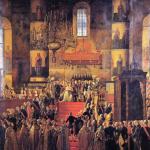Isis- goddess of fertility, water and wind. Twin sister and wife of Osiris, mother of Horus. In the myths of many peoples, marriage between gods - brother and sister - was one of the manifestations of their divine essence. Osiris and Isis fell in love with each other in their mother’s womb; the Egyptians revered Isis as the embodiment of a faithful, selfless wife and caring mother. (See Osiris and Burn for the plots.)
Isis, a loving wife who remained faithful to her husband Osiris even after his death, and the selfless mother of Horus, more than other goddesses, was an example to follow. Egyptian art abounds in her images, which is why she is so familiar to Egyptologists. Isis holds a special place in the Egyptian pantheon and was consulted on every occasion.
Isis's loyalty did not waver, even when Osiris was killed by his brother Set. She returned the breath of life to her husband, and he was able to be reborn and become the ruler of the kingdom of the dead. Isis, an intelligent and perceptive woman, was also very cunning. And thanks to these qualities, she gained almost limitless power over the world.
Her images
In the art of Ancient Egypt there are thousands of images of Isis. Paintings, stone statues, bronze figurines and amulets give us a clear idea of this goddess. She is usually shown seated, kneeling or standing, and the details may vary slightly. Seated Isis often holds her son Horus on her lap, whom she sometimes breastfeeds. It is crowned with a solar disk, which is held by two curved horns. Kneeling Isis holds a shena (cartouche) in front of her. The standing goddess is crowned with the sign of aset (seat), the main hieroglyph of her name. She can take the form of a bird of prey - a detail borrowed from the myths of Osiris. Then, in addition to her arms, she has large kite wings.
Hathoric images of Isis - with cow horns holding the sun rather than with the hieroglyph aset as a throne - indicate the fusion of two goddesses, Isis and Hathor. This identification, characteristic of the Late Period, is explained by the fact that both goddesses symbolized fertility.
Myths about Isis
Isis is one of the host of goddesses of Ancient Egypt, but she called herself “the one to whom fate obeys.” Where does such self-confidence come from? Its origins lie in the exemplary life of wife and mother that Isis led, but also in the cunning that has always been characteristic of her.
Surprisingly, the one whom the ancient Egyptians called “the mistress of life” could never have been born because of one event that happened at the dawn of time, when Atum-Ra was still creating the world. His children - Shu (air) and Tefnut (water) - united and gave birth to two gods: Heb (earth) and Nut (sky). And they fell in love with each other so much that heaven and earth merged into one! Neither the sun, nor the air, nor the water could move anymore! Ra was furious. He forced his son Shu to separate the lovers, which caused several earthquakes!
The one that might not have been born
But Nut was already carrying five children under her heart. Among them were Isis and her brother Osiris. The vindictive Ra decreed that none of these children could be born in any of the twelve months of the calendar. But the inventive god Thoth won five extra days from the Moon, which he placed after twelve months. Thanks to him, Nut was able to give birth to Isis on the fourth of these days (the so-called “epagomenal”). And all living things joyfully praised Thoth.
Isis talks about himself
“I am the mother of all nature, the mistress of all the elements, the firstborn daughter of centuries, the highest of deities, the queen of shadows, the mistress of heavenly powers, the single manifestation of all gods and goddesses, to whose will the shining peaks of the sky, the welcoming sighs of the sea and the mournful silence of the underworld obey.” Words of Isis, Roman era.
Isis and the myths of Osiris
“I will restore the body of Osiris, I will embalm him and spread my wings over him... I will conceive from him and bring forth Horus into the light,” said Isis. The goddess's life was overshadowed by a terrible family history. The cause of this tragedy was the envy that the god Set had towards his brother Osiris. Isis, the latter’s sister and wife, could not stop Seth from killing his brother: he had been hatching his criminal plan for a very long time. When the murder occurred, Seth threw the coffin with his brother's body into the waters of the Nile. And the search began for Isis, who made every effort to return the remains of Osiris. She was assisted in this act of love and devotion by her sister, Nephthys. The “Divine Mourners,” that is, two goddesses, managed to find the coffin and hid it in the swamp of Khemmis. However, Seth did not abandon his intention to kill his brother. He discovered the cache and dismembered the body of Osiris into fourteen pieces, which he scattered throughout Egypt. But Isis was persistent; she collected these pieces and gave them to the good god Anubis. The embalmer god restored the body. Burning with marital love, Isis conceived from her reborn husband the most famous of the Egyptian gods, Horus. Osiris became the ruler of the underworld, and the loving and persistent Isis became a perfect woman in the eyes of the Egyptians.
Cunning sorceress
Texts about Isis found by researchers say that “her heart was more rebellious than that of a myriad of people, and more intelligent than that of a countless number of gods.” So, with insatiable curiosity, Isis longed to know the secret name of Ra, the god who created the sky and light. After all, if she had achieved her goal, it would have increased her power over the other gods a hundredfold! In the end, in order to find out the secret of the head of the Egyptian pantheon, the goddess resorted to an amazing trick. This is how the myths tell about it: “Ra became decrepit and began to drool... His saliva dripped onto the ground. Isis took it, mixed it with earth in her palm and fashioned a snake out of it, then threw it onto the road along which the great god was walking... And the snake bit him!” Ra, frightened, called his children-gods for help: “Something that my heart does not know has stung me... My heart trembles, and my limbs are full of cold.” Isis, like all the gods, submissive to his will, immediately appeared to him and said: “Tell me your name, divine father, because the one whose name is pronounced in the spell will remain alive!”
Cult of Isis
The cult of the goddess Isis eventually became almost universal. She was worshiped everywhere: from the entire territory of Ancient Egypt to the remote provinces of the Roman Empire. Rituals performed in the name of the goddess have become overgrown with secrets over the centuries, and the walls of temples have become overgrown with legends about the “great sorceress.”
During the Greco-Roman era, Isis was the object of everyone's attention. The Ptolemies, who continued the policy of their builder predecessors, erected many temples in her honor. During this period, the Debod Sanctuary appeared south of Aswan, which was dismantled in 1960 and rebuilt in the Western Park of Madrid. From the end of the Pharaonic era until the beginning of the Roman era, several more temples were built in Nubia. The temple of Kalabsha (the ancient name is Talmis) was dedicated simultaneously to the Nubian god Mandulis and Osiris and Isis.
But the most famous is the temple of Isis on the island of Philae (in Egyptian, P-i-lak). Due to the construction of the Aswan Reservoir and the threat of flooding, the Philae complex was moved to another island, but did not lose any of its majesty and romance. We owe the decision to build up the Nile island of Philae to Nectanebo I, a pharaoh from the XXX dynasty. In the middle of the island in the 4th century BC. e. A large temple dedicated to Isis began to be built. It soon became one of the largest places of worship of Isis in the ancient world. Subsequent pharaohs only contributed to the development of the cult of the “Divine Spouse”. Construction was continued by the Roman emperors in the 2nd century AD. e. The temple was finally closed only in 537 AD. e. by order of Emperor Justinian. The sanctuary fell into oblivion, and the statues from it were transported to Constantinople. The hypostyle hall of the temple turned into a Christian church - confirmation that the cults of the Mother of God and the nursing mother Isis were closely connected. And, undoubtedly, it was thanks to this connection that the Philae sanctuary was able to exist for so long, even when polytheism was replaced by monotheistic religion.
Isis with the Child
A seated Isis, dressed in a tight-fitting dress, holds little Horus on her lap and breastfeeds him. The bird of prey wig was, according to ancient beliefs, a reference to her maternal role. These figurines of Isis and the Child were most often made as votive items. On the stand of one of them we can read the dedication: “May the revered Isis, the mother of God, give life and health to Ken-Hor, the son of Padi-Neit, born of Kheribu-Wajit.”
Isis visits the left foot of Osiris
Legend has it that after Osiris was dismembered and pieces of his body were scattered throughout the country, the left leg, found by Isis, was kept west of Philae, on the island of Bige. This island, immersed in silence, was called by the priests “iu-uab” (pure island). They organized a meeting between Isis and the relics of her late husband. From now on, Isis - or rather, her revered statue from Philae - every ten days went on a sacred boat to Osiris for the Sacrificial Libation of Milk. This visit had a very special meaning, because it was here that the roar of rising water was heard first every year. The sign of an approaching flood was associated with the revival of Osiris and nature, which occurred thanks to Isis. The beautiful stone pavilion, built under the Roman Emperor Trajan for the sacred boat of Isis, became the most famous monument of the complex on the island of Philae.
Delta: spread of the cult of Isis
At the other end of the country, in the Nile Delta, the pharaohs of the XXX dynasty had no less reverence for Isis. Thus, the settlement of Behbeit el-Hagar became famous for one of the largest temples dedicated to this goddess. Today it is completely destroyed, although it was made of granite blocks. It is assumed that the style of the bas-reliefs that decorated its walls influenced the decor of temples of the Greco-Roman world. By the way, it was in Rome, in the main sanctuary of Isis, built much later than the temples of the Delta, under the emperor Caligula, that a sculpted stone block from the temple of Behbeit el-Hagara was discovered. This is irrefutable evidence of close contact between the religious worlds of Ancient Egypt and powerful Rome. In addition, a fresco with Isis was found on the walls of one of the villas of Herculaneum, a city near Pompeii. It is depicted so accurately that we can confidently assume that the artist has already seen similar drawings in the Campanian city. Let's return to Egypt: even in Giza, famous for its pyramids, a city that people never left, in the Sais era (during the XXVI dynasty) there was a temple of Isis. It is not for nothing that the goddess was called “the mistress of the pyramids.” The inhabitants of Alexandria also worshiped her. This port city, which produced and exported objects of the cult of Isis to the Greco-Roman world, helped spread the belief in the “great sorceress”. From Greek territories to the most remote provinces of the Roman Empire, Isis, who mysteriously conceived, was revered everywhere, as a nurse and loving mother. And, apparently, in the story of the Nativity of Christ, the Christian religion learned something from this myth.
Isis, goddess of worldwide cult
“I am a single entity, which the whole world honors in different images, under changing names and performing different rituals: some call me Juno, others Bellona, others Hecate, others Rhamnusia. But the peoples of the two Ethiopias and the Egyptians, strong in their ancient knowledge, honor me with a cult suitable to me and call me by my true name - Queen Isis.” (Words of Isis, Roman era).
Epithets of Isis
The sorrowful events that marked the life of the goddess were reflected in her epithets: first of all, she is a “great deity”, “mistress of life” of both the newborn and the deceased. Wasn't she the one who brought her husband back to life? Isis is the “divine nurse” of the king, because Horus, whom she holds on her lap and breastfeeds, according to ancient beliefs, is embodied in every pharaoh. As an exemplary wife, she is called the “inconsolable widow,” “the one who seeks.” In the myth where the goddess brings the dead back to life, she is likened to the flood of the Nile, which comes every year from Nubia to revive the dry lands of her beloved Egypt: she is the “Lady of Nubia.” Finally, Isis is called the “great sorceress” because of her power.
Isis-Sothis, star goddess
A long time ago, at the dawn of the history of Ancient Egypt, the priest-astronomers who compiled the solar calendar noticed a strange phenomenon in the sky: after disappearing for seventy days, the star Sirius, which the Egyptians called Sothis, reappeared at the horizon level, and immediately the sun rose. Today this phenomenon is called heliacal sunrise. People noticed that the heliacal rising of Sirius coincided with the beginning of the annual flood on the Nile. And then the star began to be considered a prophetess, a harbinger of an event that all of Egypt was waiting for. Water, whole streams of water, finally saturated the land scorched by the merciless sun for several months. As a food-giving goddess, Isis quickly became identified with Sothis. “I am the one who gives the blessed flood,” she declares. Parched Egypt needed a lot of water, but too much, as well as too little, could harm it. All harvests and, consequently, the existence of the entire country depended on this balance. The heliacal sunrise heralded the beginning of the new year, and Isis-Sothis became its revered symbol.
Isis, protector of the dead
Isis, the goddess who managed to resurrect her husband Osiris, who was treacherously killed by the envious Seth, was naturally revered as the protector of all the dead. And although there were no special rituals associated with her on the occasion of the funeral, she was invariably present at these ceremonies in the form of images that ancient Egyptian craftsmen painted or carved on the walls of sarcophagi. She protected people from all the dangers of the afterlife, helping them, as she once helped Osiris.
For example, a powerful granite box, inside of which the sarcophagus of Ramesses III was placed (Paris, Louvre), is decorated with the image of two goddesses: Nephthys (at the head) and Isis (at the feet). The wife of Osiris kneels over the hieroglyph “gold”. She extends her arms with large kite wings in a protective gesture. This pose resembles one of the main symbols of the goddess: the Isis knot. This amulet is similar to the ankh cross of life, but differs from it in two hanging ends.
Isis the healer
The love, although not devoid of power, that Isis had for her son Horus, as well as her abilities for magic, made this goddess the patroness of mothers and their children. With her skills, which any woman could envy, she won many admirers. After all, Isis was able to save from any poison, her words were enough to “return life to a choking throat”! And poisonous creatures were found in abundance in Egypt! In this desert country, full of snakes and scorpions, children were in constant danger, and Isis must have often heard the pleas of mothers asking for the life of their children to be restored.
Ancient Egyptian goddess Isis
In Egyptian mythology, the goddess Isis was the goddess of fertility, wind and water, a symbol of family fidelity, femininity, and also the goddess of navigation. The cult of this goddess was widespread in Egypt and even far beyond its borders, especially during the Hellenistic era. In the Greco-Roman world, she was often called “she of a thousand names.” Isis was the daughter of Nut and Geb, sister of Nephthys, Set, Osiris (she was also his wife). Mother Horus. The main legends about Isis associated with the myths of Osiris. There she usually acts as a faithful and devoted wife. After Set killed Osiris, she found her husband’s body, buried him and, having conceived from her dead husband, gave birth to a son, Horus, who was obliged to take revenge on the murderer. The myths describe in sufficient detail the life of the goddess in the Nile Delta, where she, hiding from Set, raised Horus.
One day, while she was away, a poisonous snake bit the baby. His body was motionless, and his heart was powerless, the vessels of his small body did not beat. Isis screamed, calling on people and gods for help. Thoth, the god of wisdom, responded, calmed the unfortunate mother and healed Horus. When Horus grew up, Isis together with him she went to the court of the Ennead (nine gods) and began to demand the royal throne for him (this is legal - after all, he is the son of Osiris). Seth insisted, and Isis was removed from the trial. The gods gathered on the Inner Island and forbade the carrier to deliver Horus's mother to the island. However, the wise goddess deceived Seth. Taking the form of an old woman, she gave the ferryman a beautiful gold ring, and he agreed to transport her to the sacred island. There she turned into a beautiful girl and told Seth about the shepherd's son, who was robbed by a stranger, depriving him of his dead father. Seth was outraged by such illegality and exclaimed that the stranger should be beaten with a stick. By this he condemned, without knowing it, himself, recognizing that the inheritance should go to his son.
In all further disputes and clashes between Horus and Set Isis always helped her son. When Set penetrated the hand of Horus and filled it with poison, Isis I tore off my bad arm and replaced it with a healthy one. She ensured that Seth was condemned, and her son Horus became king of Egypt. Name Isis mentioned in almost all texts dedicated to Osiris. It is also mentioned in the legend about the dispute between Set and Horus.
In some myths Isis is a completely independent goddess and Osiris is not even mentioned. In magical texts (Metternich's stele), Osiris is mentioned only in passing, with the goddess and queen in the foreground Isis. In the mysteries that are dedicated to the death and resurrection of Osiris, Osiris was silent, but Isis and her sister Nephthys made long speeches mourning the death of Osiris. Relationship Isis, Osiris and Horus were considered an extremely instructive example of family. However, such an interpretation of the image was far from original. There was also a mention that said that Isis stands on the side of Seth, the worst enemy of his son and husband. At the same time, the following explanation is given for this behavior: when she, standing up for her son, hits Seth with a harpoon, he says, “What am I to blame for you? Isis? Call back your harpoon, for I am your brother by mother.” After this he says that Horus is not native to Isis, since he belongs to his father's family. Confused by such speeches, Isis takes the harpoon, and Horus, enraged by such a betrayal, cuts off her head. This version of the myth is very archaic. Isis acts in this myth according to the norms of maternal law, which say that the maternal brother is the closest person. And Horus, as a representative of the next generation of gods, acts according to the norms of paternal law. He is much more closely connected with his father, and for his mother he is much less dear than his own brother. This ancient myth was subsequently included in the presentation of the myth about the dispute between Horus and Seth, although it does not at all fit into the thread of the narrative.
At the beginning Isis was revered only in the northern part of the Nile River Delta, and the center of its cult was the city of Buto. Most likely, she personified the sky, since her very name (“iset” - “throne, place”) hinted that the solar god Horus came from her. Worshipers of the cult Isis- fishermen. According to myth, when trouble happened to Horus, they were the first to come to the rescue.
As a sky goddess, she was depicted as a cow or a beautiful woman with cow horns on her head. Subsequently, the mother becomes the mistress of the sky Isis Nut, and Isis herself takes on the usual image of the assistant and wife of Osiris.
Honored Isis also as the goddess of the wind, who creates it with her wings, accordingly she was depicted as a falcon or a woman with wings. Together with Nephthys and the goddess Heket Isis acts as the patroness of women in labor - a goddess who facilitates childbirth and determines the entire fate of newborns.
Like the wife of Osiris, Isis periodically assumes its functions. According to Diodorus Siculus, she taught people to grow grains and reap them. The Greeks identified Isis with their mother goddess Demeter. However, most often, Osiris himself performed the functions of a farmer. Along with the myths that the water of the Nile flows from its belly, there was the idea that the river overflows from tears Isis who is grieving for her husband. According to the traditions of antiquity, Isis ruled not only over rivers, but also over the seas and patronized sailors.
None of the gods of Egyptian mythology (with the exception of Serapis) received such wide popularity in antiquity as Isis. In the 4th century BC. temple Isis was built in Piraeus on the island of Delos. There are also known sanctuaries dedicated to her in Tiphorea, Cenchrea and other Greek cities.
In Italy, her cult has been spreading since the 2nd century BC; temples were erected to her in Pompeii, Rome, Benevente and other cities. There are monuments that testify to the cult of the goddess Isis in Britain, Gaul and Spain. Initially, her cult was associated with the cult of Osiris, but in the Greco-Roman era she became independent and came to the fore, taking on more and more functions as the spouse of Osiris. The authors of antiquity wrote a lot about Isis. Cult Isis also greatly influenced Christianity. The image of the Mother of God with a child in her arms goes back to the image Isis with the child Horus. Figurines of the goddess remained as relics in some medieval churches.
Isis was the Egyptian Goddess of Magic. She was originally associated with the throne of Egypt, which had magical powers because it could turn a prince into a king.
Later, Isis “absorbed the attributes of most other goddesses and gods and became the supreme deity known for her healing and redemptive powers.
She was the sister and wife of Osiris. In Ancient Egypt, incest was considered normal in the lives of the Egyptian gods as it upheld the sacred bloodline of the divine image. The Egyptian goddess Isis was endowed with everything that the ancient Egyptians most respected in the female form. After her husband's death, she became the protector of the dead. In her love and devotion to Osiris, Isis became the symbol of a loving wife, and after he passed into the world of the dead, she became a symbol of the Mother in her protection and devotion to her only son Horus.
Everyone bowed before her kindness and gentleness, regardless of class: slaves and “sinners” prayed to her. She also supported nobles, rich people, and royalty. She was everyone's ally...
The goddess Isis personified fertility and love for everything around her. As the goddess of magic, she represented death, healing and birth. Isis used her magical knowledge and connection with nature to help others. She happened to become the first child of the God of the Earth - Geb, and the heavenly goddess Nut.
Isis in magic
- Meaning: fertility, water, wind, fidelity, marriage, magical arts
- Image: throne, solar disk, on the hands of the goddess - wings.
- Colors: green, red, blue, black
- Day - Mon.
- Attributes: milk, wine, cedar, rose, horn, lapis lazuli, crescent, snake.
- Stones: obsidian, gold, silver, carnelian, lapis lazuli.
Other names for Isis
The name "Isis" that we use today comes from the Greek "Isis", which we pronounce as "eye-sis", although the Greeks would say it more like "es-es". "Esis", "Isia", "Isi" and "Esia" are other Greek variations. In Latin, her name became "Isis" and "Isis".
Both the Greek and Latin forms are in turn derived from ancient Egyptian variations, "Aset" also spelled "Auset" and "Ast". The final "t" is a traditional feminine suffix in ancient Egypt. In later periods it was sometimes dropped in pronunciation. All the names of the goddess were related to the word “throne”.

Protector of the Dead
An important role of the goddess Isis was that of protector of the dead. They prayed to her and asked her to help her soul go a long way. She is one of the guardians of sarcophagi from evil spirits. Isis guarded the vessels that contained the internal organs of the deceased. She was associated with the kite hawk, which was seen flying over dead bodies, and was seen by the ancient Egyptians as a form of protection for the dead.
Great love affair
The myth of Isis and Osiris is perhaps the greatest love story of ancient times. Osiris, brother and husband of the Egyptian goddess Isis, was to inherit the world and be the king of men. When he was alive, he ruled Egypt in his human form and was considered a great and good ruler. He was loved by both mortals and gods... except one... her younger brother Set. Seth was unhappy with this and began to feel great envy towards his sister's husband.
At some point, Osiris left Egypt to spread civilization to other lands, and Isis was left in charge of governing the country, with the god Thoth appointed as her assistant. She coped well with her new mission, but now the time has come for her husband to return. But Set betrayed the trust of Osiris, drove him into a trap and killed him.

When Isis became aware of what her brother had done for the sake of the inheritance, she could not come to terms with the death of her husband and decided to return him. Set, having killed Osiris, tore his body into many small pieces and scattered it throughout the Egyptian land. Anubis came to the aid of Isis (the illegitimate child of Osiris and her sister Nephthys, whom Isis adopted and raised as her own). Together, Isis and Anubis pieced together the body of Osiris and created the first Egyptian mummy. Isis, taking the form of a female falcon, sat on her husband and covered him with her plumage, quietly chanted a spell and conceived her first-born (Horus) from her dead husband. Unfortunately, no magic was strong enough to return her husband to the throne, and he descended to reign in the underworld, becoming the God of the Underworld.
Having given birth to her son Horus, Isis is forced to hide in the eastern part of the Nile River to protect her child from Set. She raised and educated him until he, as an adult, was able to receive a legal inheritance. At the divine trial, Isis forced Seth to confess to the treacherous murder of Osiris and transfer the inheritance to Horus. For a very long time, Isis was next to her son and helped him in the fight against Seth. She knew that Horus would not only become an avenger of his father, but one day he would come and rightfully conquer the throne of Egypt.
Image of Isis
There are two most common images of Isis, which appear in sculptures, frescoes and sarcophagi. The first image is where she is kneeling or floating with her green (when colored) wings outstretched. Sometimes in these images her skin has a blue tint. The second image is where she wears a headdress made of cow horns and a sun disk, as well as a belt associated with tit, the magical knot that gives life. In this depiction, she is usually seated on a throne feeding Horus, or she is standing holding a sistrum (musical rattle) in her hand.

In the first image, the wings, headdress, colors used and gestures depicted have symbolic meaning. The wings of Isis symbolize either falcons or kites, which are birds of prey. They scream with sounds “reminiscent of the screams of distraught women.” Thus, wings represent both strength and mourning. They also symbolize the resurrection power of Isis, who, through her plumage, tries to give breath to her dead husband.
From time to time the wings are painted green, as green symbolizes life and resurrection in Egyptian art. They also symbolize security because they are depicted as prostrate, which is a protective gesture for the Egyptians.
Her headdress is the Egyptian hieroglyph for throne, which is also the hieroglyph for her name. As the hieroglyph for throne, it represents her magical powers because the throne was believed to have magical powers. In addition to this, the throne represents the "primary order of beginning" because "in its forms lies the original hill" which "first emerged from the waters as habitable land." The throne is associated with the circle of Isis on the head, and through this the headdress reinforces the belief that the king's strength depends on it. The headdress is often depicted as blue, symbolizing the heavens and the primordial flow (and by extension, life and rebirth). Thus, the headdress refers to Isis's ability to give life to the king through the power of the throne. The fact that Isis's skin is sometimes depicted as blue reinforces the belief in her powers over life and death and her importance to all people.
Isis (Isis, Isis, Iset, Ise, Isi) is one of the most revered and great goddesses of the ancient world. Isis absorbs into her image the strongest values and abilities of a woman: wisdom, sincere femininity, power, the lunar principle, fidelity, mystical powers, motherhood, love and sexuality, support. It represents the lunar image of the reflection of sunlight.
Her lover invariably remained the god Osiris, the ruler of the pharaohs, and subsequently the ruler of the afterlife. She was both his sister and wife. She fell in love with her husband in the womb, and subsequently did not change her decision and always supported him.
It is worth noting that the love here between brother and sister is spiritual in nature. Isis had already chosen her husband when they were both not yet born, but were in a formless state; such souls are called relatives by purpose.
Isis gave birth to a son who was the crown ruler of Egypt. Isis, like Osiris himself, was the daughter of “heaven () and earth (the god Geb).”
Symbolism
Isis was depicted as a beautiful woman with bird wings, on whose head was a symbol of the royal throne (in other versions, a solar disk framed by a cow). The sacred animal of the queen of Egypt was the great white cow of Heliopolis.
Other well-known attributes are the “Teth” amulet (or “Isis knot”), the scepter (a symbol of power), and in some cases the cross of life Ankh.
Often depicted as a woman breastfeeding a baby, the son of Horus or the pharaohs.
Divine Functions
- Isis primarily represents woman in all aspects, as mother and spouse. Its functions of maintaining life and fertility are connected with this. Helps women during childbirth.
- The owner of great magical powers, the mistress of spells, as well as such qualities as flexibility, endurance and cunning. The magic of life and resurrection was especially emphasized in the myths about the scattered parts of Osiris. It holds the keys to influence the forces of the Universe.
- Acts as the progenitor of people, the mistress of the Universe
- A mentor to women in teaching them the feminine arts. According to the ideas of the ancient Egyptians, it was she who taught women to weave, spin, heal ailments, and educate. She is the founder of the institution of marriage.
Energy channel of ISIDA
In communication with Isis, she appeared in the form of a strong, focused woman in a white dress with gold jewelry.
What does the channel of the goddess Isis give?
- A wise mentor for women in various areas of life. Will teach you how to properly manage a household, be tactful and measured
- Increases mental abilities, develops attention
- Charges with strong energy a woman who is realized or knows what to do
- Isis's task is to support a woman's family
- Develops female magical abilities (intuition, attraction, female charms, abundance, beauty, sexuality, female power in a good sense, managing your life and others).
Additionally: The channel works only with women.
Energy connection occurs using technology. The channel is given forever.
Cult
The most significant centers of veneration were the cities of Hebet (not preserved today), the temple on the island of Philae in the south of Egypt, Dendera, Koptos, Abydos, and there were also temples in other regions of Egypt. It was believed that Isis was connected in a special way with Sirius, where her spiritual essence is located.
Later, her cult began to spread further and temples dedicated to her arose outside of Egypt in Italy, Rome, Nubia, and Athens.

Titles
Bears the epithet “Beautiful”; “Great with charms, first among the gods”; "Mistress of the Gods." Having received the name Ra, which means the most powerful magical powers, she began to be called: “She who knows Ra in his own name.” In cosmic terms, it correlates with the star Sirius in the constellation Canis Major, which is why it bears another title, “Mistress of the Stars.”
"Mother of the Pharaohs"
Isis, an ambitious goddess whose main duty is considered to be caring for her family, never forgot about her own importance. That’s why the beauty put so much effort into returning the throne to her own son, because being the mother of a pharaoh is much more honorable than being a simple fugitive. However, even without the brilliant Horus and the faithful Isis occupied an important place in the Egyptian pantheon of gods. The patroness of women and fertility knew exactly what mere mortals needed.
Origin story
The origins of the cult of the goddess lie in the small city of Sebennit, located in the Nile Delta. Before taking the place of the patroness of the pharaohs, Isis was revered mainly by Egyptian fishermen. The city of Buto was considered the place of worship of the goddess.
The initial image of the woman is noticeably different from later images of the beauty. Isis was depicted with the head of a cow, but the spread of the cult was reflected in the woman’s appearance. When the influence of the wife of Osiris expanded throughout ancient Egypt, the unattractive face of the cow was replaced with a beautiful face. Only the horns remaining in the same place reminded of the previous image.
The goddess gradually acquired relatives, as well as her own myths and legends. With the advent of the Ancient Kingdom, Isis acquired the status of wife and assistant to the divine pharaoh. And if previously a beautiful woman was perceived as the patroness of the sky, now Isis was assigned the responsibility of controlling the wind. From that moment on, the goddess was depicted as a winged maiden.

Merging with the cult of Osiris provided the woman with greater influence and more responsibilities. Now Isis was perceived as the protector of the dead, the patroness of pregnant women and a symbol of fidelity, femininity and maternal love.
The goddess began to be depicted with flowing hair. The woman was dressed in a silver dress, and the goddess often held a bucket (the flood of the Nile) and a musical instrument, the sistrum, in her hands. Often the statue of a beauty was wrapped in a cloak, the hem of which was embroidered with flowers. This served as a reminder that Isis is an expert in medicinal herbs and decoctions.

By the time of the formation of the New Kingdom, Isis had become more famous in Egypt than her own husband. The cult of the goddess spread to Greece, where it was initially renamed cult. But later the woman gained fame under her own name. True, the goddess lost its main meaning, while acquiring erotic symbolism.
In the 2nd century BC, the name of Isis sounded in the territory of Ancient Rome. Temples were erected in honor of the goddess in Pompeii and Benevento. From there the cult spread to Europe and Asia. Researchers claim that some elements of the worship of the Egyptian deity are reflected in Christianity.
Myths and legends about Isis
Isis is the eldest child of the earth god Geb and the sky goddess Nut. Soon after the girl’s birth, the couple had more heirs: Osiris and Nephthys. After Osiris was proclaimed pharaoh of Egypt, the goddess married her younger brother.

The marriage, which others considered political, was built on love and mutual respect. Therefore, when the evil Set killed Osiris, the woman directed all her strength to return her beloved.
The suffering widow searched for the body of her lover for a long time and accidentally discovered the coffin with Osiris in a tree that had sprouted on the banks of the Nile. Isis turned into a kite, hugged the body of her dead husband and, casting a spell, resurrected Osiris. Alas, the magic was only enough to indulge with the god of love. After this, Osiris returned to the world of the dead, and Isis was left alone with the newborn baby Horus in her arms.

The exiled wife of the pharaoh vigilantly looked after her son and tried in every possible way to return the throne of Egypt to the rightful heir. When Horus became old enough, Isis convened a council of the gods and demanded justice. Knowing that the truth was not on his side, Seth insisted that Isis not be allowed into the council.
With the help of magic, the woman turned into an old woman and, deceiving the guards, went to the chambers of the invader pharaoh. Before entering her younger brother, the goddess took the form of an unfamiliar beauty. Seth, who always paid attention to attractive women, could not resist this time either.

The man tried to take possession of the stranger, but the disguised goddess asked to first listen to a sad story. Isis said that she married a shepherd who was killed. And a stranger came and seized the husband's cattle, depriving the shepherd's son of his inheritance. The blinded Seth cried out that the stranger must be punished and the herd returned to the heir. At that very moment, Isis became herself again.
However, even such a recognition did not bring Isis and Horus closer to the throne. There were still a number of tests to be completed. The mother, who wanted to help her beloved son, threw a harpoon at Seth during the duel of the gods. The younger brother begged his sister to release him. Despite her hatred of the tyrant, Isis took pity on her husband’s murderer. Seeing that the goddess had freed Seth, the angry Horus rashly cut off his mother's head.
Of course, the great patroness of the dead did not die. The head immediately grew back to the neck. The loving mother was not even angry with her son and forgave the proud young man for his ardent outburst.

Having achieved justice for her son, the goddess wanted to raise her own name among the gods. To gain more influence, Isis decided to find out the secret name of God. Such knowledge would provide a woman with influence and power.
Noticing that Ra was already old and sick, the goddess began to collect the dripping saliva of the patron of the sun. Mixing the liquid with dust, Isis created a snake that bit the god. Ra, suffering from severe pain, called on the gods. Isis also responded to pleas for help. The woman promised to cure the god if he told the goddess his own secret name. The old man obeyed, and Isis received the status of mistress of the gods.
- The literal meaning of the goddess's name is "throne", but the Egyptians translated "Isis" as "she who stands at the throne."

- The symbol of Osiris’s beloved is the pharaoh’s throne, with which the goddess adorned her head. The second most important amulet of Isis is the tiet, or “Isis knot.” Sarcophagi and clothing of the pharaohs were decorated with similar designs.
- The ancient Egyptians believed that the flood of the Nile was associated with a deity: the river overflows its banks due to the tears that Isis shed for her lost husband.


















